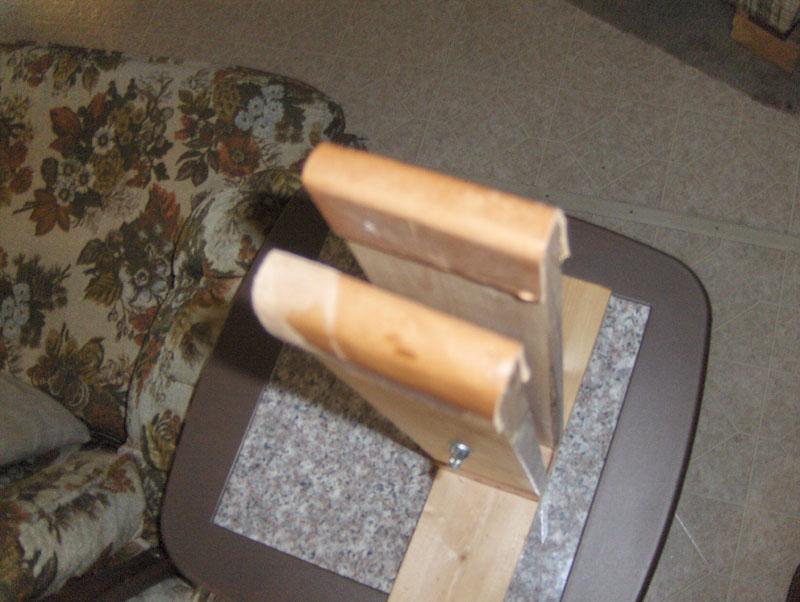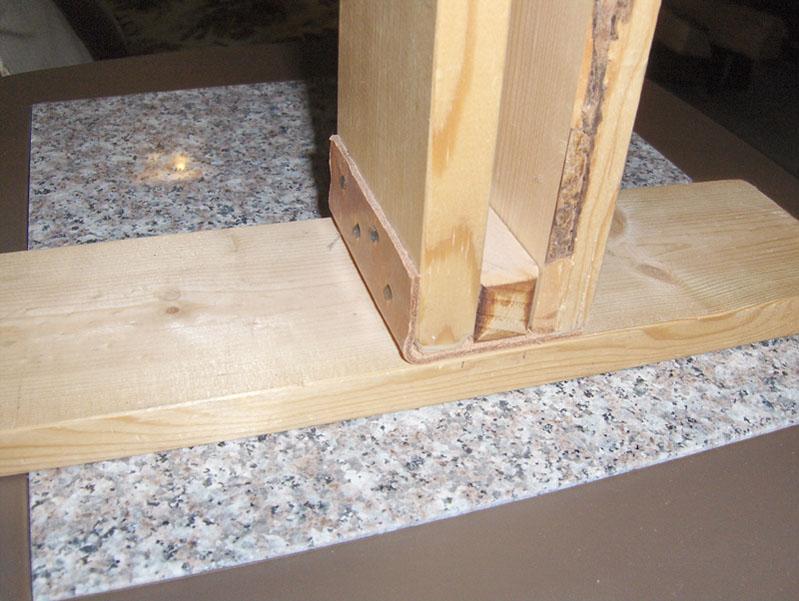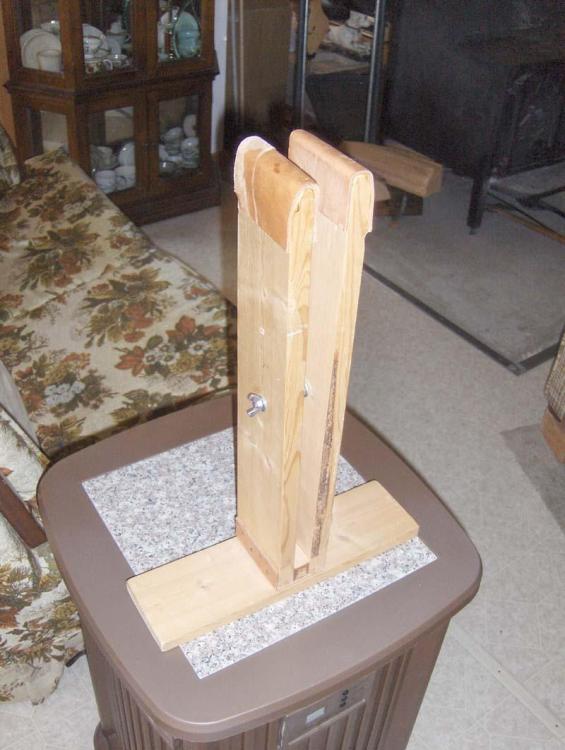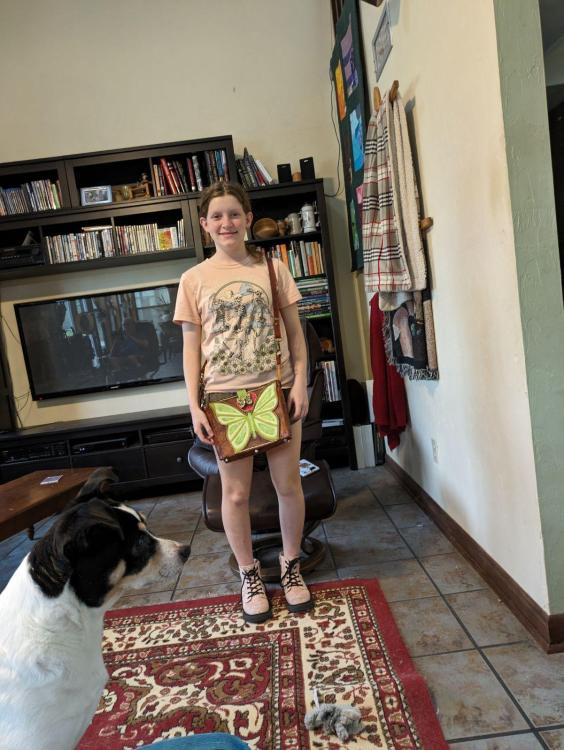-
Content Count
4,826 -
Joined
-
Last visited
Posts posted by Dwight
-
-
Take your tools to a auto parts store . . . tell em you want some black rubber tubing . . .
Check the size with your tools . . . couple feet of it will last you almost forever.
I have a bunch of tools with rubber on the handles . . . whole lot easier for 79 yr old hands to handle
May God bless,
Dwight
-
From what I could see . . . it all looked like it was there . . . only thing we could not see . . . the back was not shown . . . with the cover on it. Need to see the back with the cover removed.
The real deal though . . . have him show you a piece of stitched leather . . . preferably two pieces of 8 oz glued together . . . flesh to flesh . . . sewn with 277 or 307 nylon thread.
That should tell the tale.
I would suggest that possibly the person bought it and never really used it much . . . maybe didn't even ever learn how to use it.
The little plate and wire hook for the thread spool is missing . . . couple of inexpensive parts . . . but you don't sew without them.
Plus he has the original shoe on it . . . one that for belt and holster and wallet making . . . is useless.
Just a quick opinion . . . but google "image: tippmann boss" and you'll see the backside upper left where the thread goes . . . along with a wire that takes it up in the air and allows it to come down vertical to the machine.
May God bless,
Dwight
-
33 minutes ago, jrdunn said:Just an FYI. Pure Neatsfoot oil and Neatsfoot oil compound are two different things. I only use the pure NFO. JM2C, Jim
What he said is right on the money . . . no compound for me either . . . I saw the formula one time . . . don't recall the ingredients . . . but I voted against it.
May God bless,
Dwight
-
If you want to follow the advice of John Bianchi . . . one of THE top holster makers of the last 50 years . . .
When you cut the piece for the outside of the holster . . . turn your pattern over and cut another piece . . . that is the inside liner.
Been doing that for over 20 years . . . never been a problem yet . . . and I don't have to stock two different leathers.
May God bless,
Dwight
-
I've been lately able to get the thickness I like for belts . . . but when I can't . . . my little splitter I bought from Tandy some 10 or 12 yrs ago . . . is the go to route.
I cut the blank long enough that I've got the ability to grab the end with vise grips . . . and I run the whole thing thru the splitter . . . gets as good an edge as any of the more expensive veg tan you might buy.
The only thing is . . . ya gotta keep it sharp . . . and you need to grease it after using it . . . then wipe it down and run a 6 inch piece of scrap thru it before your belt blank . . . to take off any grease you missed.
Slicking and sanding works . . . but THIS is so much better and easier.
You will have to learn how to sharpen it and how to strop it though
May God bless,
Dwight
-
-
Can you take a micrometer and gently check the diameter of the thread ??
Looks awful big to me . . . but that may be a perception problem as I have nothing to measure it against.
May God bless,
Dwight
-
OK . . . did you laser that bird on first?
Looks good either way . . . but I'm just a wondering.
May God bless,
Dwight
-
I've done a ton of holsters in my 20+ years of leather working.
Never had anyone want one for a derringer.
This is a double barreled 410 / 45LC . . . over and under . . . double barrel.
If you've done one . . . or have a pattern . . . I'd love to see your design . . . because basically . . . I'm stumped
May God bless,
Dwight
-
I did this successfully . . . ONCE . . . and that was several years ago . . . and it was for a personal item . . . for me.
I took (I believe) . . . saddle tan dye . . . thinned it 50/50 like I always do . . . to make the saddle tan correctly first.
I then took the black dye Feibings oil base black . . . thinned it 50/50 with thinner . . .
THEN . . . I started adding the black to the saddle tan . . . then do a test piece . . . until I got the shade I wanted.
Again . . . only did it once . . . was happy with the results . . . which was a medium grey color. The tan / brown disappeared once I got where I wanted with the grey.
BUT . . . I mistakenly left the holster / gunbelt . . . hanging where excessive sunlight could hit it . . . and it bleached most of the black out.
I'm still happy with it . . . but I did like the original grey I had better.
May God bless,
Dwight
-
Saddle tan . . . my favorite color for any pretty stamping.
May God bless,
Dwight
-
From one transplanted (partial) Frenchman to another . . . welcome and glad to have you aboard.
I am baasically a belt, holster, knife sheath, and gun case maker.
I've done a bit of saddle repair . . . and a few spur straps . . . as well as chaps and chinks . . . but it is only an extracurricular activity for me.
Most of my work follows the plain / practical idea . . . but if someone wants something fancied up a bit . . . I'll usually comply with his / her request.
May God bless,
Dwight
-
-
I've never had anyone ask me to make a glock holster in anything but basic black . . .
Just my experience . . .
May God bless,
Dwight
-
Looks good from here . . .
May God bless,
Dwight
-
Thanks guys . . .
May God bless,
Dwight
-
10 hours ago, MtlBiker said:@kgg @Dwight and @bladegrinder - Thanks for your comments. I forgot to check last night when I got home, what the product is that I've been using for leather prep before applying dye, but it was some commercial product. Used to de-glaze the leather and remove contaminants. Until now, I never thought of using NFO before dyeing. I'm going to have to give it a try. Thank you all.
Just one quick note . . . when you go for example to Tandy's or other leather shops . . . the cheap stuff will be Neatsfoot oil "compound" . . . which is a conglomerate of oils.
Buy the pure neatsfoot oil . . . it's a bit more expensive . . . but it's the good stuff . . .
May God bless,
Dwight
-
-
Good way to go is find something you need to do . . . and do it . . . post pictures . . . ask for comments.
Generally speaking most folks here are gentle . . . but honest in their admiration and / or criticism . . .
The old saying goes something like . . . "most of our good decisions come from experience . . . and experience comes from bad decisions"
My first holster I made . . . no one on here has or will see . . . it was that ugly . . . but looking at others . . . I was able to see what I did wrong.
It's at the bottom of my holster box . . . rarely eve sees daylight.
Jump in . . . join the fray . . . and "glad to have you"
May God bless,
Dwight
-
A few years back I was having trouble with my light tan dyes . . . not being even . . . especially saddle tan.
I don't recall the impetus that moved me to try oiling first . . . I did . . . have NEVER had another problem like that since.
I use a cheap pig hair brush from Harbor freight . . . put on a very light coat . . . just enough to make it look wet . . .
Let it "dry" for 24 hours . . . the dye goes on perfect . . . every time.
I don't always oil for black . . . it depends on the leather . . .
But if it is anything other than black . . . it ALWAYS gets oiled first.
That is for all my holsters . . . belts . . . sheaths . . . and gun cases . . . which is mainly what I do.
May God bless,
Dwight
-
Yessir . . . been too busy with holsters to really jump into the belt thing . . . but I most certainly will be doing that.
I tried one application of the oak leaves . . . did the cardboard thing first . . . liked it . . . tossed a piece of junk leather in there for kicks and giggles . . . turned out too dark . . . have to try again some future date.
My plan is to bring the two pieces of the belt just close enough together that the laser does not "overlay" the etching . . . and I'll go in there with my cutting and stamping tools and join them together.
Got two large semi-autos that hit the shop the other day . . . both have attached lasers . . . making holsters for them . . . and it is a "chore" for sure.
Gotta get them done . . . plus a half dozen belts . . . then "Lord willing" I may get to go back to playing and experimenting.
May God bless,
Dwight
-
There's two of us for sure.
Sometimes I use mostly my Tippmann Boss for that . . . as I can EXACTLY place the stitch where I want it.
Had to do that for a holster last week. Turned out looking really good . . . at least that was my opinion.
It was for a little FIE .22 revolver . . . and so help me . . . I could easily have made a holster for a S&W 29 . . . 6 inch barrel . . . easier and quicker than that little rascal.
May God bless,
Dwight
-
Get a Skippy peanut butter jar . . . or the like . . . nowdays they're plastic . . .
Mine has a mark about 1 1/2 inches above the bottom . . . and another about 3 inches up.
Fill up to the bottom line with water . . . add resolene to the top line . . . I've got my mix.
Then I grab my brush . . . dip it in the solution . . . and start painting. I paint it very wet to start with . . . to the point that moving my brush back and forth will produce a lather looking pile of bubbles . . . once I get that . . . I quit adding and start stroking . . . up and down . . . left and right . . . diagonal both ways . . . and brush until there are not bubbles or streaks.
It leaves a very nice "semi shiny" finish . . .
I have not liked the results I got from adding more water . . . if I wanted a duller finish . . . I'd pick another product . . . or just oil it . . . rub it till all the dye quit rubbing off . . . and call it a day.
May God bless,
Dwight
PS: the brush in the picture is the 2 inch size . . . I actually use the 1 inch size on everything . . . belts included
-
3 hours ago, Sarina said:I
Edit: Actually the more I think about it the more I realize that there can't be an exact formula and that the way Dwight says is the only way to get it exact. Depending on the firmness and thickness of the leather, when you bend it into a circle the circumference of the inner part shrinks as it gets squished but also the circumference of the outer part grows some as it stretches. The exact amount depends on the type of leather and how big the circle is, so you can't make a formula that calculates it exactly.
Actually, Sarina . . . I would only do that for a circle that I knew would be say 14 to 18 inches in diameter . . . or less . . . and only if I knew that the wrinkles on the inside would be a problem for the user or wearer.
For example . . . if my customer wanted a "stuffed" nose piece on a bridle or halter . . . a showy piece . . . I would get the measurement from the horse . . . make a round piece that width and that diameter . . . because I know the nose of a horse is tender . . . and if I made the piece and there were several large wrinkles inside it . . . they could rub and irritate the animal . . . which I would never allow if at all possible. I'm a horse lover guy. It would probably be less of a problem for a collar for a small dog . . . but in that case . . . it would be an ugly and "not professional" looking product . . . so again I'd make the model . . . so my finished product looked really nice if at all possible.
I have access to power tools and lumber . . . so for me to make a circle that is 13 inches in diameter is a piece of cake . . . taking me all of 25 to 30 minutes . . . I would staple or otherwise fasten the inslde piece of leather to the wood model . . . form the rest of the pieces . . . and then using an awl . . . punch thru the leather . . . into the wood . . . for the stitching.
Once the pieces are made . . . I then glue them together with Weldwood contact cement . . . and they are easily stitched using my Cowboy 4500 or in some cases . . . sewing it by hand . . . with a stitching pony.
For rivets . . . I just do the same thing . . . punch thru the leather into the wood . . . and not worry about it . . . I've done it many times.
Not being able to do it any other way . . . I find that "necessity is the mother of invention" . . . and needing it done makes me invent a way to do it.
May God bless,
Dwight











leather hat
in Show Off!!
Posted · Report reply
I did one . . . once . . . don't wear it often as it is kinda heavy on the noggin
May God bless,
Dwight